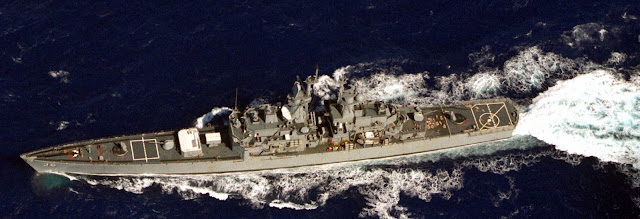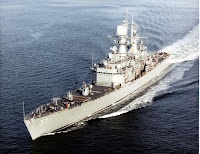sherkhan
New Member
- Joined
- Jan 20, 2010
- Messages
- 49
- Likes
- 52

The California class cruisers were two nuclear-powered guided missile cruisers operated by the United States Navy between 1974 and 1998. The class was built as a follow-up to the nuclear-powered Long Beach,Bainbridge, and Truxtun classes. Like all of the nuclear cruisers, which could steam for years between refueling, the California class was designed in part to provide high endurance escort for the navy's new Nimitz class nuclear aircraft carriers, which were often limited in range due to their conventionally powered escorts continuously needing to be refueled. A third ship was approved but it was soon cancelled in favor of the improved Virginia class. Other than their nuclear power supply and lack of helicopter hangars, the ships of California class were comparable to other guided missile cruisers of their era, such as the Belknap class. The Californias were considered larger and even more sophisticated than Truxtun, a nuclear-powered cruiser derivative of the Belknap class, and returned to the double-ended concept although using single-arm launchers.

CGN-37 South Carolina. Photo: Don Vansant
This class was the first class of nuclear-propelled surface warships intended for series production. However, only two ships of the class were built. These ships were followed on by the four nuclear-powered cruisers of the Virginia class. These six cruisers were named for states because they were seen as quite large, powerful, capable, and survivable ships. USS California (CGN-36), the lead ship of the California-class of nuclear-powered guided missile cruisers, was the seventh warship of the United States Navy to be named for the State of California and the first non-battleship ever to be named after a state. USS California was the fourth nuclear-powered cruiser in the U.S. Navy; the previous three were the USS Long Beach (CGN-9), USS Bainbridge (CGN-25) and USS Truxtun (CGN-35). The second California class cruiser, USS South Carolina (CGN-37), was the fifth nuclear-powered cruiser in the United States Navy.

Click to enlarge and save the image to view the details: modified photo of USS California cruiser of U.S. Navy.
For a high resolution image click here.
The nuclear-powered engineering plant allowed the nuclear-powered cruisers to conduct operations over extended periods of time anywhere in the world. The two propulsion plants of Californias for example allowed sustained speeds in excess of 30 knots (nautical miles per hour) all over the world! Moreover, the ships of the class, had the new version of the D2G reactor whose core had three times the life of that fitted on Truxtun. Other than the four ships of the Soviet Navy's Kirov class, which were actually built with a combination of nuclear and fossil-fuel propulsion, no other country has launched nuclear-powered cruisers.
The six Virginias and Californias in formation.
Photo: Anthony A. Alleyne, US Navy

Virginias and Californias together.
Photo: P. M. Collins

Virginias and Californias together

USS South Carolina in 1995 after her final modernization
Californias were designed to combat all threats, in the air, on the surface, and underwater. To aid in accomplishing their assigned tasks, these ships were equipped with an extensive array of weapons and sensors. USS California and her sister ship, USS South Carolina, were equipped with two Mk-13 launchers, fore and aft, capable of firing the Standard SM-1MR (Medium Range) or SM-2MR surface-to-air missiles (SAM), one Mk-16 launcher for Anti-Submarine ROCkets (ASROC), and two quadruple Mk-141 launchers for Harpoon surface-to surface (SSM) missiles. The new Mk-13 launcher could not launch the ASROC so a separate launcher and magazine were required. They were equipped with two Mk-45 5in dual-purpose rapid-fire guns, fore and aft. Californiawas the first ship to mount the new lightweight 5in gun and the first ship to mount the new digital missile fire control radars. Four 324mm torpedo launchers (two on each side, protruding from their magazine space on the main deck) were fitted for Mk 46 light weight anti-submarine torpedoes.
The ships also were originally designed to carry and launch the Mark 48 torpedo from a large space beneath the flight deck aft. Although a surface-launched version of the Mk 48 was never produced, the ships retained this large magazine space until their retirement. Two Mk-15 Phalanx 20 mm Close In Weapons Systems (CIWS) were fitted in the 1980s. A variety of sensors and radars were included in their electronic equipment including passive electronic surveillance and jamming systems unequaled by any other cruiser in the Navy that time. These weapons and sensors gave them the ability to attack and defend against targets that were over 70 nautical miles away while been able to protect themselves from close range attacks. However, the two ships had a major disadvantage: they did not have a helicopter hangar, just only a landing pad aft and basic refueling equipment.
















